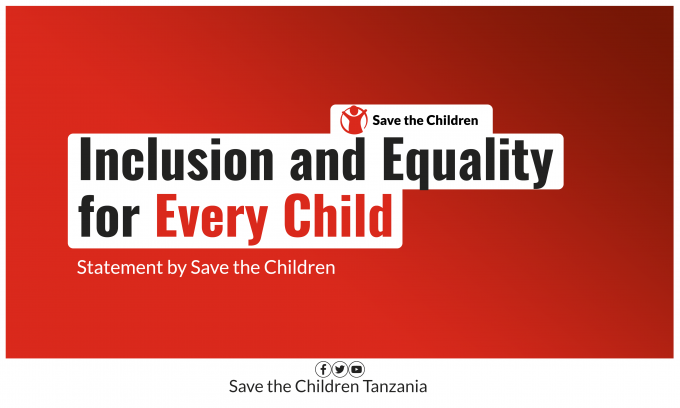Inclusion and Equality for Every Child-Statement by Save the Children

The origin of the United Nations Convention on the Rights of the Child is a culmination of the process initiated by founder of Save the Children- Eglantyne Jebb who submitted the first Declaration on the Rights of Child to the League of Nations in 1924. The League of Nations later adopted the declaration in an extended form in 1959. The declaration among other things called for the right of children to survival, learn and be protected; the very foundation of our work today. This declaration was later adopted by the United Nation in 1989 and ratified to be what we call today the UN Convention on the Rights of the Child. To us as Save the Children, this day is very personal to us as it reminds us of the core of our work as an organization, and as individuals.
With more than 100 years since these initiatives started, we are celebrating some achievements as well as setbacks in the realization of children’s rights. Tanzania in particular, we have areas that we have improved including the enactment of children’s specific regulations, access to essential services such as education and health and establishment of child-led structures such as Junior Councils. With these achievements, there are also setback for children’s to survive, learn and be protected. On the right to survive, statistics shows that 32% percent of children under five years are stunted (have low height-for-age) and 58% suffer from anemia. In addition, while there is 10.9 million of children who were enrolled in primary school between 2016-2020 the quality of education and access to services still a challenge. This is even challenging to children with disabilities were statistics shows that while there are 400,000 school aged children in Tanzania Mainland, only 42,783 are enrolled in primary schools and 8,778 in secondary schools.
Article 19 of the CRC calls for state to protect children from violence, abuse and neglect, bad treatment or exploitation by their parents or anyone else who looks after them. Physical and Humiliating punishment is among of these abuse and violence inflicted on children and institutionalized by our laws and regulation. In Tanzania, corporal punishment remains widely used both in schools and at home as a means of disciplining children and provided for in the Education Act of 1978 and its guideline N.24 of 2002. The policy and practice around corporal punishment is against UNCRC in which Tanzania is signatory for since 1991. According to a study by Hakielimu, 90% of schoolchildren in Tanzania Mainland have been canned making it the leading form of physical violence experienced by schoolchildren[1]. Reports indicate that there is excessive use of corporal punishment, which in turn inflicts severe bodily harm and injuries to children. The 2021 report on Human Rights, there were five documented cases of corporal punishment that resulted in grievous bodily harm and two that resulted in deaths[2]. In addition, Knowledge and awareness about alternative and positive means of disciplining is necessary among teachers and parents. .According to the findings of the Tuwekeze Pamoja research project by Save the Children, 89% of teachers who participated in the research disagreed that teachers have a duty to discipline children in ways that cause physical pain; and 92% of teachers disagreed or strongly disagreed that stubborn children need to be hit to teach them right from wrong. While this is known among teachers, the research also found out that 56% of the teachers still used corporal punishment as a means of disciplining at least in the past month of the study despite acknowledging that corporal punishment is not necessary.
Lastly, impacts of climate change remains one of the major underlying crisis in attaining children’s rights. Research and evidence have established that climate change and other environmental crises are multiplying the drivers of child marriages – including poverty, displacement, conflict and loss of education. Many areas with the highest rates of child marriage are also those facing the greatest effects of climate change and related environmental crises. The practice tends to be common among those with the lowest access to resources and lower income, particularly in rural areas where people depend on the local environment for their livelihoods. Natural disasters and unsustainable practices have led to a loss of resources. For some families affected by this, child marriages are a way to reduce pressure on limited resources or even earn income or resources through social practices such as ‘bride price’ paid to girls’ families.
While we commend many great efforts by the Government of Tanzania, we also call the Government of Tanzania to;
- Put children, their voices and demands at the centre of climate commitments and policies, especially children most impacted by inequalities and discrimination.
- Invest in safety nets and other essential services such as school feeding programs, to benefit the children and families threatened by the climate crisis.
- Amend the Education Act and its regulations to abolish corporal punishment in schools and promote the alternative means of disciplining. Save the Children will be ready to pilot the training and provide support to schools on the corporal punishment
- Fast track the amendment of Law of Marriage Act and ensure that children especially girls are safe
 Tanzania
Tanzania